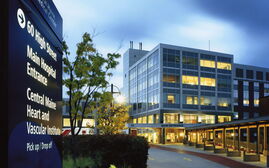MaineHealth's specialists use technology to expand their reach
The intersection of technology and modern medicine is where Corey Fravert, director of neuroscience services at Maine Medical Center, spends much of his waking hours. He can go into the weeds on both topics if necessary. But in explaining why the recent launch of the MaineHealth Telestroke Network is an important initiative, Fravert wastes no words in getting down to the basics.
“Time is brain,” he says, explaining that human nervous tissue is rapidly lost as a stroke progresses, making every second and minute critical in identifying, evaluating and treating someone having a stroke. Quick and appropriate treatment can limit damage to the brain and increase the chances of full recovery. Ideally, it should happen within three hours of the stroke's onset. Optimum care for stroke victims is literally a race against the clock.
In recent years, he says, best medical practices for emergency stroke victims have identified the timely administration of thrombolytics (clot-dissolving medications) as a critical life-enhancing step that should be taken as soon as possible after a stroke victim's arrival in a hospital emergency room. But there's an important caveat: The intravenous administration of the tPA clot-busting medicine involves a lengthy checklist that needs to be followed to ensure that it's the appropriate treatment. And not every emergency room doctor or nurse has the level of expertise that's needed to go through that complicated decision-making process.
“We have specialists who live, breathe and sleep it,” Fravert says of neurologists based at MMC in Portland and Pen Bay Healthcare in Rockport who are able to provide 24/7 guidance regarding the best medical practices for treating acute ischemic stroke patients to emergency department physicians at other facilities within the MaineHealth Telestroke Network.
By using secure two-way videoconferencing technology, MaineHealth's telestroke initiative enables member hospitals in Belfast (Waldo County General Hospital) and Damariscotta (Miles Memorial Hospital), its St. Andrews urgent care center in Boothbay Harbor and the independent Mid Coast Hospital in Brunswick, a MaineHealth affiliate, to provide high-quality stroke care for patients within their own communities. Another affiliate, MaineGeneral Medical Center in Augusta, is in the process of converting its existing telestroke network to MaineHealth's network.
With Maine having the highest stroke death rate among the six New England states — and strokes being the fifth leading cause of death in the United States and the No. 1 cause of major disability — Fravert says the telestroke network is a critical tool for improving patient outcomes, decreasing stroke-related disability and health care costs and keeping stroke patients close to home in a largely rural state that's unable to support specialists outside of urban areas where there are sufficient numbers of patients to pay their salaries.
The early evidence, he says, is encouraging.
Here's one example: Shortly after the telestroke network was launched, Fravert says, the emergency department at Miles Memorial Hospital received a call from local EMTs that a possible stroke victim was en route. The emergency department doctor mobilized his staff to be ready to conduct a CT brain scan as soon as the patient was stabilized. At the same time, a neurologist 50 miles away at MMC in Portland became part of that team via a secure videoconferencing network that creates real-time opportunities for the specialist to examine, diagnose and recommend treatment for patients with stroke symptoms as if he or she were physically there.
It only took 32 minutes from the time of the patient's arrival to the administration of the tPA clot-busting medicine, Fravert says, which is almost half an hour faster than the American Stroke Association's gold standard of 60 minutes or less. Integral to that performance, he adds, is the fact that the hospital's emergency department team and the MMC neurologist beat the telestroke network's internal benchmarks for notification and launching of the videoconference — in both cases by roughly half the target times.
“It starts with the people in the emergency department,” Fravert says. “You have to have champions of the program who really want to see it succeed. … We're trying to make those decision points be as seamless as we can. We meet monthly with providers and go over the key quality indicators for every call that happened. We use the quality benchmarks to identify where we can improve moving forward.”
Investing in telehealth
Dr. Jackie Cawley, chief medical information officer at MaineHealth and associate chief medical officer, describes her dual roles as “providing clinical leadership for all things technology” in relation to the overarching goal of providing the best health care possible. Launched earlier this year, the telestroke network is part of MaineHealth's multi-year $200 million investment in an integrated health care system using Epic software, which organizes clinical data for each patient, often from multiple sources, into a single record.
What that means in practice is that the emergency department physician and the consulting neurologist will have the same comprehensive up-to-date health record of the potential stroke patient on which to guide their medical decisions. That's important because the American Heart Association/American Stroke Association guidelines for using the clot-busting tPA medicine include a 20-point checklist that identifies several medical conditions in which it would not be the appropriate treatment.
Epic's integration of each patient's health history around one record, Cawley says, greatly improves patient safety. Coupled with improvements in high-speed Internet technologies and the availability of relatively low-cost laptop or tablet computers and mobile platforms, it's an essential element of MaineHealth's other telehealth initiatives to provide specialized care in pediatric genetics, speech pathology, radiology, psychiatry and other specialties.
“You can't disconnect the technology from the medical care we provide,” Cawley says. “It's all very connected. These are the tools we need right now to make sure every patient receives the best care that we can give them. We've made a strong commitment to use whatever technology is out there that will improve the care for our patients.”
Meeting Maine's need
Dr. Rosemarie Smith is a clinical geneticist with Maine Medical Partners, a pediatric specialty care practice based in Portland, and one of only three full-time clinical geneticists in Maine. “We tend to deal with pretty rare things, so we tend to be affiliated with major medical centers,” she says, noting that her specialty deals with birth defects that can cause health problems; conditions such as Down syndrome or fetal alcohol syndrome; and diseases such as cystic fibrosis or hereditary conditions that might put a couple at risk of having children with similar problems.
Smith says videoconferencing technology is an important tool for bridging distances in a state where it can take five hours or more to drive from Aroostook County to her office in Portland. For almost 10 years, she's been using it to connect with patients at the Cary Medical Center, located 300 miles away in Caribou. “I definitely believe you need to reach out to your patients if they can't come to you,” she says. “My job is to provide people the information they need in the most convenient way I can. That's very important to me.”
Although Smith regularly makes a five-hour drive to Caribou for scheduled visits with referral patients — saying, “It's important to have a personal relationship” with them — she uses videoconferencing for diagnoses, family counseling and consultations with pediatric and family doctors. “A lot of my examinations are very visual,” she says, “so for many of these cases I get a good first look by using telemedicine.”
Once a diagnosis of a birth defect or genetic disorder has been made, she works closely with the families and their local doctors to make sure an appropriate follow-up care plan is created to help the child be as healthy as possible and achieve his or her fullest potential. Doing that by telemedicine, she says, spares those families the 600-mile roundtrip from Caribou to Portland, lodging and meal costs and time lost from work for one or both parents. “There's no question many of these families wouldn't follow through with that consultation if they had to meet with me in person,” she says.
MaineHealth's telemedicine speech program, based at Waldo County General Hospital, taps the expertise of a cluster of 12 speech language pathologists based there who are led by Michael Towey, director of The Speech Language Pathology Voice and Swallowing Center of Maine. “We call it 'telepractice' or 'telerehabilitation,'” Towey says, noting that his team provides 30,000 minutes per month of speech therapy at 21 different locations throughout Maine via videoconferencing. “A lot of our work is done with young children who are having problems with speech and language, which puts them at great risk of academic failure. We're able to provide services to kids who don't have access to a speech therapist otherwise.”
Towey says the center also works with stroke patients who've lost their ability to speak, as well as laryngeal cancer patients who are learning how to speak with a mechanical voice box.
“Centers of excellence can occur anywhere,” he says. “We have an extraordinary little hospital here in Belfast where we're encouraged to think differently about how we provide health care. We're also fortunate to have 12 speech therapists with different areas of expertise who are really innovative, so patients from just about anywhere in Maine are able to match up to the correct expertise without having to travel for those services.”
Read more
Federal funding will support distance learning, telemedicine programs
















Comments